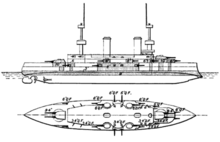SMS Mecklenburg
Mecklenburg spent the early period of her career in I Squadron of the German fleet, participating in the peacetime routine of training cruises and exercises.
The German High Command withdrew the ship from active service in January 1916 due to a threat from submarines and naval mines, together with severe shortages in personnel.
In June 1897, Hollmann was replaced by Konteradmiral (KAdm—Rear Admiral) Alfred von Tirpitz, who quickly proposed and secured approval for the first Naval Law in early 1898.
Her armored belt was 225 millimeters (8.9 in) thick in the central citadel that protected her magazines and machinery spaces and reduced to 100 mm (3.9 in) on either end of the hull.
[6] Mecklenburg, the last ship of her class, was launched on 9 November 1901; the ceremony was attended by Frederick Francis IV, Grand Duke of Mecklenburg-Schwerin.
[10] Mecklenburg had to enter the drydock at Kaiserliche Werft (Imperial Shipyard) at Wilhelmshaven for minor improvements and repairs following her trials; this work lasted until the end of February 1904.
After these modifications, Mecklenburg took part in individual and squadron training exercises, and a fleet review for the visiting British King Edward VII in June.
Mecklenburg then participated in the annual autumn fleet exercises, which took place in late August and September, and a winter training cruise in November and December.
Repair work was completed at the Kaiserliche Werft in Wilhelmshaven by 20 April, allowing her to participate in the normal routine of training cruises and maneuvers with the fleet for the remainder of the year.
She returned briefly to active service in 1912 from 9 to 12 May to move her from the North Sea to the Baltic, and again from 14 August to 28 September to participate in the fleet exercises that year.
[12] After the outbreak of World War I in August 1914, Mecklenburg and the rest of her class were mobilized to serve in IV Battle Squadron, under the command of Vice Admiral Ehrhard Schmidt.
[12] Starting on 3 September, IV Squadron, assisted by the armored cruiser Blücher, conducted a sweep into the eastern Baltic in the direction of the Svenska Högarna islands.
[15][12] From 5 December to 2 April 1915, Mecklenburg and the rest of the squadron were assigned to guard duty in the North Sea, based in the mouth of the Elbe.
She was to replace the worn-out armored cruiser Prinz Heinrich in the reconnaissance forces of the fleet in the Baltic, but Mecklenburg and her sisters were removed from service shortly thereafter.
Furthermore, the increasing threat from British submarines and Russian mines in the Baltic by 1916, the latter of which sank the armored cruiser Friedrich Carl, convinced the German navy to withdraw the elderly Wittelsbach-class ships from active service.
The ship was briefly retained after the German defeat at the end of World War I,[20] but was to be discarded under the terms of the Treaty of Versailles, which limited the re-formed Reichsmarine to eight pre-dreadnought battleships of the Deutschland and Braunschweig classes, of which only six could be operational at any given time.
She was sold to Deutsche Werke, a shipbuilder based in Kiel, on 16 August 1921 for 1,750,000 Marks, and was broken up for scrap metal that year at Kiel-Nordmole.

